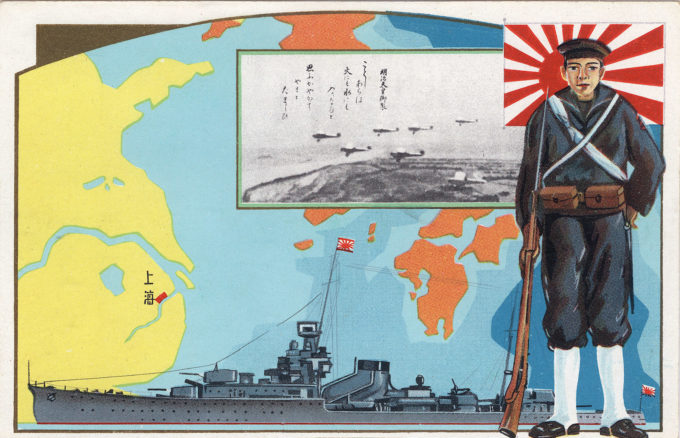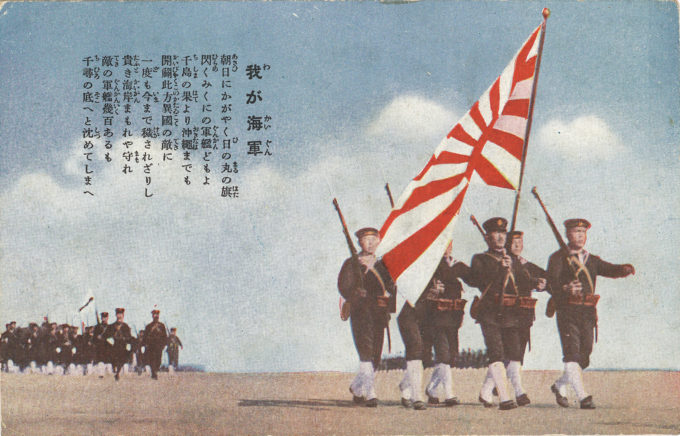
Imperial Japanese Navy Shanghai Naval Landing Force (SNLF) Marine propaganda postcard, 1932., pictured over a map depicting the location of Shanghai (上海, Shiyanhai), China, and a Yubari-class light cruiser. Assigned to the Yokosuka Naval District, Yubari was ordered to Shanghai, China, on January 26, 1932, after the staged rioting had begun that prefaced the First Shanghai Incident, carrying the Shanghai Naval Landing Force (later renamed ‘Special Naval Landing Force’) past Chinese forts at the mouth of the Whangpoo River in an end-run around Chinese troops. Yubari would also be active at the start of the Second Sino-Japanese War in August 1937 to assist in the evacuation of Japanese civilians from coastal cities in southern China. The Yubari was originally laid down in 1923 as an experimental cruiser, and presented a radical departure in appearance from previous designs with her clipper bow and combined, swept-back main funnel that would mark the beginning of the “modern” period of Japanese naval design.
See also:
Imperial marine paratroopers at the Battle of Manado (Menado), c. 1940.
“Starting in the Meiji Era the navy began to raise units unofficially known as ‘special naval landing forces’. These were not a marine force, but were instead sailors who had basic infantry training and were employed in landings as early as the Russo-Japanese War and the Boxer Rebellion. Tactically, the SNLF avoided assaults on heavily defended positions, attempting instead to leapfrog opposition and land supplies and reinforcements as quickly as possible.
“The forces were raised from kaiheidan at — and took their names from — the four main naval districts/bases in Japan: Kure, Maizuru (deactivated following the Washington naval treaty, reactivated in 1939), Sasebo, and Yokosuka.
“In 1927 some of these early units were unified under command of the ‘Shanghai Naval Landing Force’ and saw action in China from 1932 in the January 28 Incident, afterwards becoming the first official ‘Special Naval Landing Force’ [kaigun tokubetsu rikusentai] unit in October 1932. Other official SNLF units attached to the four naval districts were authorized in 1936.
“SNLF units would once again see action at the Battle of Shanghai (1937) and countless other battles and cleanup operations throughout the Second Sino-Japanese War. In 1941, the 1st and 3rd Yokosuka SNLF were converted to parachute units. The SNLF paratroopers were successfully used during the attack on Celebes and the Battle of Manado.
“The SNLF gained the distinction of being the first foreign forces to establish a foothold on American soil since the War of 1812, when troops of the Maizuru 3rd SNLF landed on Kiska Island, Alaska without opposition on June 6, 1942 and occupied the island as part of the Aleutian Islands Campaign during World War II.
“After a year of occupation, with reinforcements from thousands of Imperial Japanese Army (IJA) soldiers, they completely evacuated Kiska Island on July 28, 1943 two weeks before Allied forces were landed to dislodge them.”
– Wikipedia


